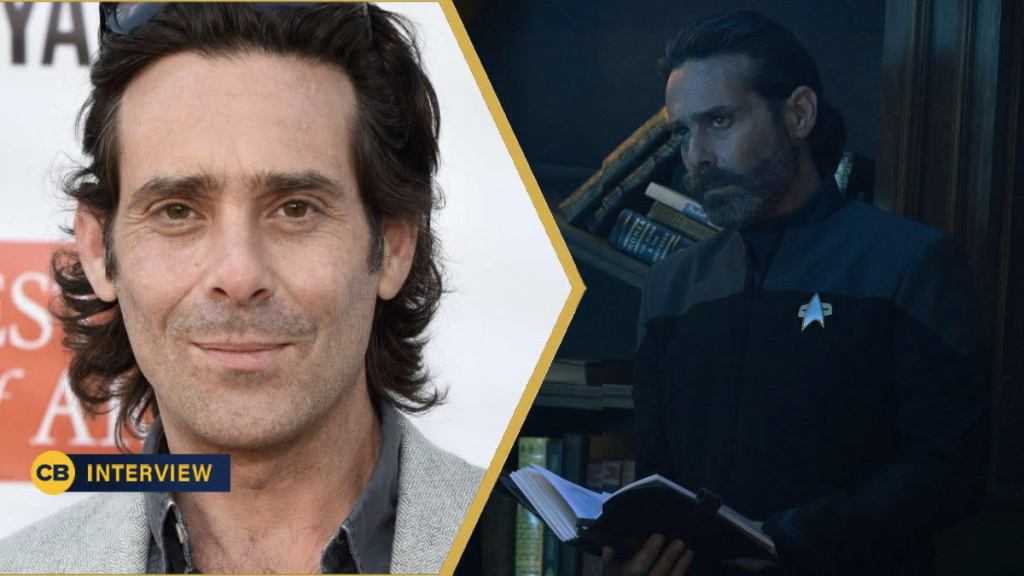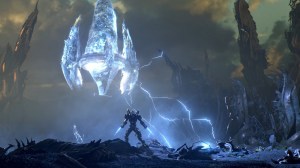The most recent Star Trek: Picard episode, “Monsters,” was unusual. The majority of “Monsters” is spent inside of Jean-Luc Picard’s (Patrick Stewart) head as he, with help from Tallinn (Orla Brady), tries to make his way back to consciousness. This mental journey is framed by a conversation that Picard is having with a Starfleet therapist, eventually revealed to be a manifestation of Picard’s memories of his father, Maurice Picard. Battlestar Galactica plays Maurice in the episode, helping Jean-Luc realize what’s holding him back and how little he really knew about who his father was.
Videos by ComicBook.com
Maurice Picard has appeared only once before, played by Clive Church in Star Trek: The Next Generation‘s “Tapestry.” Coincidentally enough, it was another instance of Jean-Luc having a near-death experience with Q involved. But Picard gives us a more extended look into the Picards’ father-son relationship. ComicBook.com had a chance to speak to Callis about bringing Maurice to Star Trek: Picard. Here’s what he had to say:

Before joining Picard, what was your history with Star Trek? Did you grow up watching some version of the series, or as a fan of sci-fi in general, or was this universe new to you?
James Callis: I was into Star Trek. I don’t say necessarily in a massive fan capacity. I think I was into adventure stories and this was an adventure in space. So I was familiar with Captain Kirk and Spock and Bones and Scotty, all of that stuff.
I actually became, genuinely, a bit more a fan of the show while doing Picard and watching back lots of episodes of the various franchises that I hadn’t seen that starred Patrick Stewart. And that was awesome. And I think I’ve become more of a fan of science fiction because of the way that it can allow you to tell stories. I mean, essentially, it allows you to tell almost any story.
Knowing that, did you have a sense of the gravity in playing Picard’s father, who we don’t really know much about from past Star Trek episodes? Or was that something you gleaned later?
That thing is only hitting me a bit now because the episode’s come out. At the time, when I first heard about it, when I was first reading it, I really thought that I was just the psychologist. So the revelation that it was a manifestation of the father was really news to me. And yes, until I got there, I wasn’t quite sure how we were going to do it all.
So they didn’t give you the complete information on who you were playing when you were auditioning?
They might have done. There was a lot going on. They might have. I know that there was definitely something about, “It’s not quite what you think.” And the thing as well, when I was told about the potential of being Picard’s father, I didn’t know that the psychologist wasn’t necessarily real either. It really was a voyage of discovery for me.
You worked on 12 Monkeys with Terry Matalas previously. Did he come, seeking you out for this role, or was this more a reunion more coincidental?
No, with parts like this, I don’t think they knew who they were going to have. And I think that’s pretty much the same as when I auditioned for Gaius Baltar. Initially, it was like, “We are looking at everybody. Every kind of person could be Gaius Baltar.”
And I think then with this, it fit — Is it something about the way we’re all progressing? — because there’s a meta thing as well, obviously, because of me being in Battlestar previously. But yeah, I think that it was just maybe like a happy accident.
The way these things are, now it’s finished and it’s done, it’s like, “Of course, of course, it was supposed to be like this.” I think that’s panache, rather than the way it really was.
I wondered because of how Matalas revealed you’d be in the episode. It seemed like he was leaning into that meta angle you mentioned since he tweeted a photo from the episode with something referencing your 12 Monkeys role as the Witness and then “So say we all.”
The thing is as well is, obviously, you can only really reveal the secret once. And then, as time goes on, and there’s a lot of other things going on in the world, when somebody catches up with this, they won’t necessarily know where it’s going, and the secret will be revealed all over again, which is great. But for the longest time, we have been keeping this a secret, because the whole idea that I was, in some fashion, even doing an episode or two of Star Trek has been under the radar, I think we can say.
As we touched on a bit, you’ve got some sci-fi credits in your resume with Battlestar Galactica and 12 Monkeys. How did working on Star Trek compare to those shows?
How to say this? They are different because of the material, the personnel, and even as well, actually because of the time difference, the equipment. So I can honestly say that the stuff behind the scenes on Star Trek is more like looking at a spaceship than things on the spaceship. The technology is just incredible. It is jaw-dropping. There’s a video village, and they say, “It takes a village,” it really does.
Part of Battlestar was, I think, getting a kind of a gritty cinéma vérité, handheld, three cameras, very rarely locked off, gives that movement. And 12 Monkeys, most of which I got to shoot in Prague, which was just incredible, had its own cinematic literature or lingo, but we were a unit on the move on location.
Again, that’s a different kind of deal, different set of kit, in the way that you are managing. Not that all of these things aren’t planned, because they are, but every situation brings you things that you’ve got to improvise within. Then you get to Star Trek, and they’ve really thought of it all, everything. It seems like there’s very little margin for error if there’s any margin for that at all.
I’d worked actually with the director of photography on CSI, with Ted Danson, and I remembered the DOP. The first scene that we did was with Ozzy Osbourne back in the day, and it was flipping awesome and so was Ozzy, and it was lit so beautifully. And so, it was really exciting to see the DOP again, lighting this. And when they explained to me what was going on, the way that camera tracks in my scenes with Sir Patrick Stewart, that’s a work of art in itself, really, I think.
Can you talk a bit about working with Stewart? I know he’s a producer on the show and takes the Picard character very personally. Did he get involved in helping develop how Picard’s father should be played?
My first professional job was on the stage in London, on the West End, with Bob Hoskins, may he rest in peace, and it was a two-man play. The thing about a two-man play, like a two-handed scene, as the director of the time told me, is, “Something’s the matter. And you guys are going it’s a bit like boxing match in the theater, an exciting thing that goes on, as two people confront one another.” And there’s an interesting thing about that. In a real boxing match, you’re trying to defeat your opponent. In a scene with somebody else, you are working with each other towards a desired end.
So, working with Patrick Stewart was really phenomenal. It was like an acting master class. I learned so much in just the short space of time, and he’s somebody who’s — I feel like acting is so dull. We should be talking about other stuff. Well, we’re talking about this — but acting, it’s about being. It’s not about acting. If you’re acting, you’re not doing it right, really. And he just is. And watching him sometimes, and being in the scenes with him, it was difficult to act, because you’re like the rest of the crew, just like, “Bloody hell, this is so good.” Then you’re like, “Actually, no, I’ve got to say something now. It’s my bit now.”
So, it was a real pleasure. In the scene, you are committed to this thing together. You’re really going there. I think that for me as well, there were just so many choices he made that I loved, because a smaller person would get rattled easier, or would push back and would reveal, would tell something of themselves. I just found his good-humored restraint with almost everything was just so telling. Also, as well, I’m there for, in terms of Star Trek, five minutes. This guy’s there so long, all of the hours, doing all of this stuff. If I was wearing a hat, I’d take it off to him, you know what I mean? Really. It was just phenomenal, a phenomenal lesson. And just off the set as well, a lot of fun, a lot of fun, and very funny, because he is very funny.
Is this your one appearance in Picard? Or, as much as you’re at liberty to say, should be looking out for more of you in upcoming episodes?
I believe, yeah. Don’t blink.
Since I have you, I wanted to ask you about Battlestar Galactica. Obviously, many fans know you from Battlestar, and NBCUniversal is working on a reboot or revival of that right now. Do you have thoughts or feelings about that, given what a big role you played in the previous reboot?
I mean, you would do, right? It’s an incredible canvas to play with right now. And in fact, every other day that goes on, because we’ve been talking about this — this cast as you know, are friendly, we chat with each other all the time, not necessarily that the reboot was going on, because that’s been going on — but then during the pandemic, I remember us discussing, “My goodness, we didn’t really do this.” And then somebody’s like, “No, we did. We did an episode.” I’m like, “Yeah, but not an episode.” I mean, I’m just saying the whole idea of society going through this pandemic and how that might affect it, and I suppose whatever, as well, politically, oh my God, technologically, again, it would be a very different Battlestar. And I’d say, in much the same way, although set in the galaxy far away, et cetera, it would be talking about, as it should be, right now, and the situation we find ourselves in.
Star Trek: Picard is streaming now on Paramount+.








